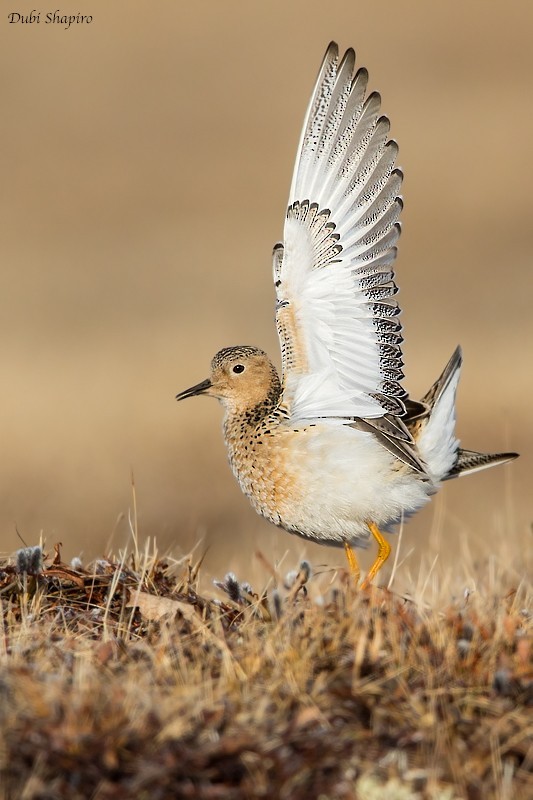Buff-breasted Sandpiper
A species of Tryngites Scientific name : Calidris subruficollis Genus : Tryngites
Buff-breasted Sandpiper, A species of Tryngites
Botanical name: Calidris subruficollis
Genus: Tryngites
Content
Description General Info
 Photo By Dubi Shapiro
Photo By Dubi Shapiro Description
This species is brown above, and has a buff face and underparts in all plumages. It has a short bill and yellow legs. Males are larger than females. Juveniles resemble the adults, but may be paler on the rear underparts. 
Size
13 - 23 cm
Life Expectancy
10 years
Nest Placement
Ground
Clutch Size
2 - 5 eggs
Feeding Habits
Buff-breasted Sandpiper primarily consumes insects and other invertebrates, including larvae and adults of beetles, ants, midges, flies, craneflies, moths, butterflies, crickets, grasshoppers, and the Bombus polaris. Additionally, their diet consists of spiders, isopods, snails, earthworms, and small quantities of seeds from plants such as knotweeds, pondweeds, and spikerushes. Buff-breasted Sandpiper employs a foraging behavior akin to plovers, moving swiftly, pausing to detect prey, then capturing it with its short, fine bill without probing the ground.
Habitat
Buff-breasted Sandpiper breeds in the open arctic tundra of North America, favoring short-grass areas with raised, dry ground close to water sources. For migration, they select dry flatlands, such as agricultural lands, avoiding flooded or densely vegetated areas. Their wintering habitats in South America encompass grasslands ranging from pastures to pampas, with a notable tolerance for diverse environments, including shallow wetlands.
Nest Behavior
The female buff-breasted Sandpiper is responsible for nest site selection, construction, and lining. Nest building commences in sync with their Arctic breeding season. After nest construction, egg-laying ensues, with females caring for the eggs and, eventually, the chicks.
Nest Characteristics
Buff-breasted Sandpiper typically selects a dry, well-drained ground site in tundra for nesting, often near a water source. Females create a scrape concealed by surrounding vegetation and line it with local materials like lichens, leaves, moss, and sedges, forming a nest approximately 3.6 inches wide and 1.8 inches deep.
Dite type
Aquatic invertebrate eater
General Info
Feeding Habits
Bird food type
Behavior
Buff-breasted Sandpiper exhibit a range of notable behaviors, particularly during the breeding season. Upon reaching the tundra, males partake in distinctive 'exploded lek' courtship displays that last for days, involving up to 17 unique postures and movements. These include crouching with raised tails and wings to waving and fluttering in midair. Competition within leks is intense, with males disrupting rivals' displays or even mimicking females to attract attention. Mating is brief, with no pair bond formed, and females are solely responsible for nesting and chick-rearing. Outside breeding, buff-breasted Sandpiper migrate and winter in flocks, establishing feeding territories upon arrival at wintering sites; males may also display post-breeding and during migratory stops.
Distribution Area
C. subruficollis breeds in the open arctic tundra of North America and is a very long-distance migrant, spending the non-breeding season mainly in South America, especially Argentina. It migrates mainly through central North America, and is uncommon on the coasts. It occurs as a regular wanderer to western Europe, and is not classed as rare in Great Britain or Ireland, where small flocks have occurred. Only the pectoral sandpiper is a more common American shorebird visitor to Europe. This species nests as far north as Canada including Alaska on the ground, laying four eggs. The male has a display which includes raising the wings to display the white undersides, which is also given on migration, sometimes when no other buff-breasted sandpipers are present. Outside the breeding season, this bird is normally found on short-grass habitats such as airfields or golf-courses, rather than near water. These birds pick up food by sight, mainly eating insects and other invertebrates. The buff-breasted sandpipers are known to prey on Bombus polaris, a species of bumblebee found within the Arctic Circle. They will either eat the bees or feed them to their young. They are often very tame. Buff-breasted sandpipers are suspected to have hybridized with the white-rumped or Baird's sandpiper. 

 Photo By Dubi Shapiro
Photo By Dubi Shapiro Scientific Classification
Phylum
Chordates Class
Birds Order
Shorebirds Family
Sandpipers Genus
Tryngites Species
Buff-breasted Sandpiper